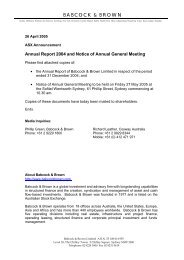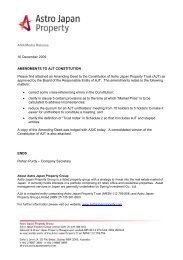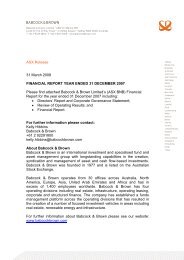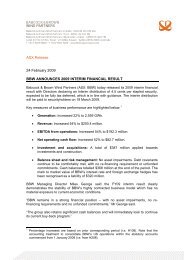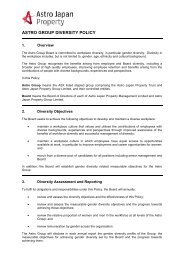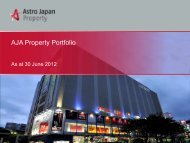BABCOCK & BROWN
bbsn supplementary prospectus.pdf - Astrojapanproperty.com
bbsn supplementary prospectus.pdf - Astrojapanproperty.com
- No tags were found...
Create successful ePaper yourself
Turn your PDF publications into a flip-book with our unique Google optimized e-Paper software.
6. risk factors<br />
6.2.8 Market conditions<br />
Unfavourable financial or economic conditions may reduce<br />
the number and size of transactions on which the Babcock<br />
& Brown Group provides advisory services. Unfavourable<br />
market conditions could also affect the Group’s ability to<br />
engage in, or exit, principal investments as well as syndicate<br />
into key markets, correspondingly reducing revenues.<br />
6.2.9 Ability to access capital markets<br />
The Babcock & Brown Group depends on a variety of markets<br />
as principal sources of funding for many transactions, including<br />
principal investment. Inability to access debt markets on<br />
acceptable terms would significantly limit the ability of the<br />
Group to fund its activities. Further, an inability to procure<br />
debt funding for clients would limit the Group’s ability to<br />
offer financing offerings and therefore reduce advisory and<br />
arranging revenues.<br />
The Babcock & Brown Group also depends on a variety of<br />
equity investors to provide funding in transactions which are<br />
either not fully funded by the Group or which are arranged<br />
by the Group. Inability to access equity investors on acceptable<br />
terms would also significantly limit the Group’s activities.<br />
6.2.10 Investment risk<br />
The investment activities of the Babcock & Brown Group<br />
may be in relatively high risk, illiquid assets and the Group may<br />
lose some or all of the amounts invested. The Group may also<br />
be impacted by an inability to exit investments when desired,<br />
or to exit investments for full value, especially where assets<br />
acquired do not have an active secondary market (or that market<br />
is volatile) or for which there is only a limited number of<br />
investors. As a consequence, the value of an asset may ultimately<br />
be less than its apparent value. The success and profitability of<br />
the Babcock & Brown Group will, in part, depend upon the<br />
Group investing in assets which have the ability to increase in<br />
value over time and where such value can be realised for cash.<br />
6.2.11 Relationship with key financiers<br />
In order to finance the transactions in which it is involved<br />
as either principal or advisor/arranger the Babcock & Brown<br />
Group accesses a wide variety of forms of debt and equity<br />
capital and associated providers. These sources vary widely<br />
depending upon the transaction in question.<br />
6.2.12 Third party obligations<br />
The Babcock & Brown Group commonly invests alongside<br />
third parties in its investment transactions. The inability of<br />
co-investors to fulfil their obligations may result in the Group<br />
being required to contribute additional capital that it did<br />
not initially envisage or not completing transactions that it<br />
otherwise might have completed.<br />
The Babcock & Brown Group may also be exposed to credit or<br />
performance risk in respect of its investments and arrangements<br />
with other counterparties. For example, in PFI contracts, the<br />
Group generally seeks to contract out construction and<br />
maintenance of facilities to third parties at pre-determined<br />
prices. To the extent that these parties cannot fulfil their<br />
contractual obligations (for example due to insolvency) the<br />
Group may be required to source these services from other<br />
parties at some cost to itself. The Group, where possible, seeks<br />
to contract with reputable parties of acceptable credit standing<br />
to mitigate such risks.<br />
6.2.13 Industry issues<br />
The business of the Babcock & Brown Group has particular<br />
emphasis on the airline, real estate and infrastructure industries.<br />
General risks in relation to the airline industry include<br />
exceptional events such as terrorism. In addition there are<br />
other business risks such as fuel costs and factors that impact<br />
air travel and holiday activity.<br />
General risks in relation to the real estate investment activities<br />
include the ability to procure tenants, timing of rental payments,<br />
demand for property from investors, expenses in operating,<br />
refurbishing and maintaining properties, and timing of receiving<br />
sale proceeds. In addition, the supply of competing existing or<br />
new buildings may affect the ability to secure lease renewals,<br />
retain existing tenants or obtain new tenants. In certain<br />
circumstances, the Babcock & Brown Group works with<br />
developers and other third party suppliers where the Group<br />
may have exposure to problems which may impact its reputation<br />
and ability to transact in the market.<br />
In relation to infrastructure investment, general risks include the<br />
risk that projects will not be completed within budget, and the<br />
agreed timeframe, to the agreed specifications and, where<br />
applicable, be successfully integrated into existing infrastructure<br />
assets. The operations of infrastructure projects are exposed to<br />
unplanned interruptions caused by significant catastrophic events,<br />
such as cyclones, earthquake, landslide, flood, explosion, fire,<br />
54 <strong>BABCOCK</strong> & <strong>BROWN</strong> SUBORDINATED NOTES



